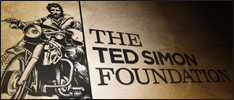Ushuaia could rightfully claim itself to be a jewel of a city. It does not contain beautiful buildings – it is mostly a collection of tin roofed single story dwellings built to withstand the horrific winter conditions of wind, snow & ice in this extreme land – nor has it a pleasing layout, built like most South American towns & cities in neat, square blocks. But it does have situation and atmosphere in trumps. A jewel on its own is not much to behold, it needs to be mounted in an ornate surrounding that displays its beauty to maximum benefit. Ushuaia has a hillside setting nestling in a cusp formed between the deep blue waters of the Beagle Channel and the stark backdrop of the snow capped Martial Mountains, with their glacier aproning the left flank as spied from the sea. Beyond these views there are more massive mountains – to the right, Monte Olivia is the dominant peak from the massed ranks of the Sierra Alvear, whilst to the left the Tierra Del Fuego National Park is trimmed with the distant Chilean Montes des Pyramides, completing the encirclement of the city on land. The Beagle Channel itself is dotted with rocky outcrops and small islands with a view across to the coastline of the larger Isla Navarino. A jewel is best viewed from many angles to appreciate its fine qualities and the opportunities exist to take boat trips out onto the Beagle Channel, whilst a pleasant 15-minute ski lift will take you to the Martial Glacier and walks abound in the nearby National Park all providing backward glances at this lovely setting.
We spent 4 nights in Ushuaia in a superb apartment – La Costa Serena, which allowed us the opportunity to cook our own food for a change (you do get tired of eating in restaurants after a few nights!). It had the added benefit of being right in the town centre, a few minutes walk from the harbour and the bustling Avenida San Martin, with its collection of fine shops & restaurants. The harbour attracts Southern Hemisphere cruise liners and every day there was one moored to the jetty adding yet another extravagant presence to the city. The harbour was also dotted with Antarctic exploration & cruise vessels – sturdy, tubby, strong little ships resting between their journeys south through the bleak wild oceans to sneak views of the white continent.
We spent a few pleasant hours at the Naval Museum set in the old prison at one end of the town. There was a superb collection of model ships – all built by a Ukranian exile, which provided an excellent timeline for the history of the area. It started with Magellan’s ship and those of other early explorers of the area. Francis Drake was portrayed as a notorious pirate, which was a bit of a shock (well maybe not as he did terrorise these waters). Then of course there was Darwin’s Beagle & the collection also included several models of boats used to serve the early missionary settlements in the area. It concluded with some fine models from the era of Antarctic exploration – Scott’s Discovery, Shackleton’s Endeavour and Amundson’s Fram. There was also a French vessel of the period called the ‘Pouquoi Pas?’ – the ‘Why Not?’ whose name tickled us.
We next learned of the fate of the native Yamana Indians. The Yamana were a simple semi-nomadic people who lived off the land around Tierra Del Fuego and the sea which they explored in their bark canoes. They were a hardy lot, going unclothed apart from a loincloth (we were amazed at this as it is freezing cold in Ushuaia with summer temperatures averaging only around 10°C) but apparently the wind & rain provided a natural cleansing that kept their bodies clean and free from infection. Initial contacts with European explorers were hostile and the tribe had a fearsome reputation for many years. However in the 1800’s this all came to an end with the installation of Christian missions and attempts to ‘civilise’ the Yamana. They were not an attractive people – eye-witness descriptions from the turn of the century portrayed individuals with long arms & legs dangling from short bodies – a posture attributed to the amount of time they spent squatting in canoes and in shelters. Darwin visited them and thought he had found the missing link, describing them horribly as a sub-human species. So it was decided that they needed to be educated in Christian ways. They were forced to wear mission clothes, which then got wet and dirty becoming breeding grounds for bacteria and disease, against which the Yamana had no in-built immunity. Coupled with other European imported diseases, such as typhoid and tuberculosis, this decimated the tribe and by 1925 there were only a handful left. Within another decade or so they were all dead and gone.
Another part of the museum was dedicated to the old prison, where one of the wings had been restored, with each cell describing various aspects of prison life and telling stories of the more notorious inmates. One that caught our eye was the story of ‘big-eared little man’ a nasty psychopath who murdered a number of children around the early 1900’s. Once in prison it was decided he was a psycho and his condition was attributed to the fact that he had sticky-out ears. Plastic surgery was duly performed to correct the condition and remove his psychosis. It didn’t work, in fact it was said that his ears quickly returned to their mad ‘wing-nut’ profile! He subsequently died from a ‘burst ulcer’ but it was rumoured that other inmates killed him, as he was a child killer.
To view Ushuaia from the sea and to take in some of the wildlife on the surrounding islands, we took a trip on the ‘Yate Kam’ a little motorised fishing boat. The islands are home to colonies of Southern Fur Seals and there were hundreds of them lazing in the sun like giant slugs, but it was the bird life that was most fascinating. Another isle held a huge colony of White Breasted Cormorants. These have reached the end of this years breeding season and the chicks have all been reared and were getting ready to take to the sea & sky for the first time. This is a very risky business as there are teams of Skuas and Giant Black Petrels surrounding the rocks on sea and in the air, waiting for a youngster to wander too far from the parents. The Giant Black Petrels were fascinating – they are huge ‘industrial sized’ seabirds, of a roughly seagull shape, but jet black with enormous menacing beaks – real stealth bombers of the maritime bird world! They are so big they have to run along the water to take off on their vast wings, but once airborne they are masters of the sky and it was amazing to watch them swoop and soar. Just as we were about to leave, a young Cormorant strayed just that little bit too far out to sea and was immediately pounced on by a Petrel. It was a grisly sight. The huge seabird sat on the little Cormorant holding it under the water until it drowned and could then be torn apart with no further struggle. But such is life and such is nature. Other spectacles included a huge Albatross, who appeared like Concorde at an air display to steal the show and a little Magellan penguin that popped up near the boat looking lost and alone.
We landed on one of the bigger islands and ate some wild berries – some ‘Calafate’ (a sort of blueberry) and some rosy red berries called ‘Manzanitos’ that tasted like little apples. We also saw some curious ring shaped mounds, creations of the Yamana. Apparently they ate lots of shellfish, which are abundant in the area, and they would discard the shells outside their circular tents such that over the years little circular walls arose around them. Back on Ushuaia in the evening we also sampled some of the shellfish, including the local speciality ‘Centolla’ – King Crab.
The Tierra Del Fuego National Park provided a number of short easy trails for a pleasant days walking and we saw some eco-terrorists at work – North American Beavers, introduced to the area to try & create a fur trade. Neither of us has witnessed such a splendid or impressive piece of vandalism as a Beaver Dam! They utterly trashed the surrounding forest and made a huge lake on the little river they had chosen to call home. But the ultimate thrill of our visit to Ushuaia was the walk up to the Martial Glacier. This starts on a ski lift 7 km outside town followed by a 1 hour hike up the trail to take you to the bottom of the glacier, which in itself is nothing special – it is fairly small and looks more like a mountainside covered in snow (it is a different type of beast to the Moreno Glacier). No, the reward for the hike up here is the awesome views back down the valley looking over Ushuaia and out to the Beagle Channel. As I said a jewel needs to be viewed from many different aspects, but this view was the best! On our way back down we rescued a Geography Teacher called Betty from Buenos Aires who had ventured up the mountain with her daughter Caroline, in inappropriate footwear. She got stuck on a steep section and could proceed neither up nor down. We had a pair of walking poles and with these we were able to return her to more stable slopes. We had a free geography lesson on the mountain formations thrown in!
Good news in Ushuaia was that Mag’s 20 days in her plaster were up & it was duly removed by the local hospital. Her arm is a bit tender and it will take another while to restore full movement and strength to the elbow. Meanwhile we will now proceed slowly back north to Comodoro Rivadavia to return the hire car and conclude this first part of our Pan American Adventure!








